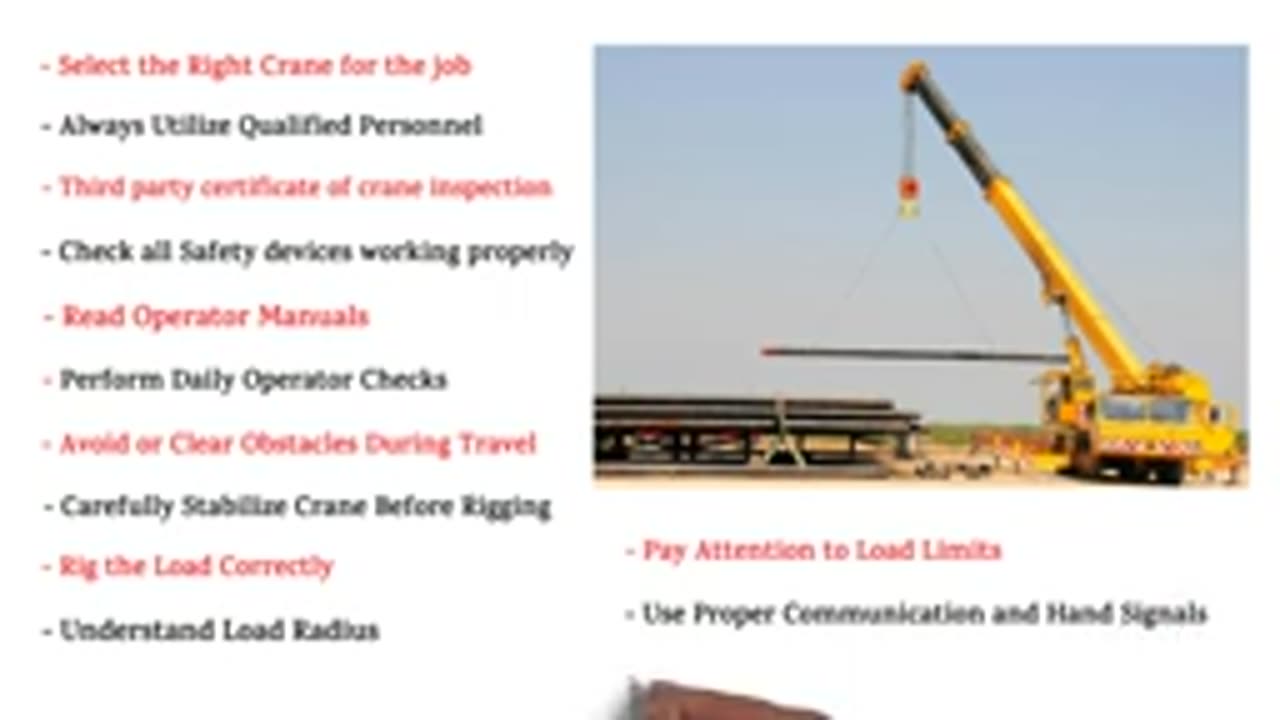Premium Only Content

13 Crane Safety Tips To Prevent Accidents _ Crane Safety Tips _ HSE STUDY GUIDE
### **13 Crane Safety Tips to Prevent Accidents - HSE Study Guide**
Crane accidents can be fatal and costly, so following safety protocols is essential for ensuring safe crane operations. Below are **13 crane safety tips** to help prevent accidents, based on best practices and HSE (Health, Safety, and Environment) guidelines.
---
## **1. Conduct Pre-Operational Inspections**
- **Tip:** Always perform a pre-operational inspection before starting crane operations.
- **Reason:** This includes checking the crane’s mechanical components, safety devices, load capacity, and hydraulic systems. Early detection of problems can prevent accidents.
---
## **2. Ensure Proper Crane Setup**
- **Tip:** Position the crane correctly before lifting.
- **Reason:** The crane should be placed on firm, level ground. Ensure outriggers are fully extended and set on solid surfaces to maintain stability during operations.
---
## **3. Verify Load Capacity**
- **Tip:** Check the crane’s load chart to ensure that it can handle the weight of the load.
- **Reason:** Never exceed the crane’s rated capacity. Overloading can lead to tipping, structural failure, or loss of control.
---
## **4. Use Appropriate Rigging Equipment**
- **Tip:** Ensure the correct rigging equipment is used for each job, including slings, hooks, shackles, and chains.
- **Reason:** The equipment should match the type and weight of the load. Always use certified equipment that is in good condition.
---
## **5. Maintain Clear Communication**
- **Tip:** Establish clear communication between the crane operator and the ground crew.
- **Reason:** Effective communication ensures coordinated movements, proper positioning, and timely response to potential hazards. Use radios or hand signals if necessary.
---
## **6. Avoid Lifting Loads Over People**
- **Tip:** Never lift a load over workers or personnel.
- **Reason:** The load could shift or fall, leading to severe injury or fatal accidents. Always ensure the lifting zone is clear of people.
---
## **7. Inspect and Maintain Safety Devices**
- **Tip:** Regularly inspect and maintain safety devices like limit switches, alarms, and load indicators.
- **Reason:** Safety devices ensure that the crane does not exceed safe operating limits and prevent the crane from reaching dangerous positions, such as two-blocking.
---
## **8. Monitor Weather Conditions**
- **Tip:** Avoid crane operations in extreme weather conditions such as high winds, rain, or lightning.
- **Reason:** Weather can affect the crane’s stability and control. High winds, for example, can cause load swings, and lightning increases the risk of electrical accidents.
---
## **9. Perform Regular Maintenance**
- **Tip:** Follow a scheduled maintenance program to ensure the crane remains in good working condition.
- **Reason:** Regular inspections and maintenance prevent mechanical failure, such as issues with the hydraulic system, brakes, or electrical components.
---
## **10. Limit Swinging Loads**
- **Tip:** Minimize the swinging of loads by using taglines or controlling the load with a steady hand.
- **Reason:** Swinging loads increase the risk of accidents and damage to the load or surrounding equipment. Taglines help to control the load and prevent dangerous swinging.
---
## **11. Provide Adequate Operator Training**
- **Tip:** Ensure that crane operators are properly trained and certified.
- **Reason:** Proper training includes understanding load charts, crane functions, and safety protocols. Untrained or undertrained operators are more likely to make errors that lead to accidents.
---
## **12. Use a Signal Person**
- **Tip:** When the crane operator has limited visibility, always use a qualified signal person to guide movements.
- **Reason:** A signal person helps the operator navigate blind spots, ensuring that the load is lifted safely and with full awareness of the surroundings.
---
## **13. Establish a Safety Zone**
- **Tip:** Set up a designated safety zone around the crane and load area.
- **Reason:** A clear safety zone ensures that unauthorized personnel are kept away from the crane and load, minimizing the risk of injury from falling loads or equipment malfunctions.
---
## **Bonus Tips:**
### **14. Check Crane Stability Regularly**
- **Tip:** Regularly check for any signs of crane instability, especially during lifting operations.
- **Reason:** Uneven ground, improper positioning of outriggers, or mechanical issues can cause instability and risk tipping.
### **15. Inspect the Crane’s Tires or Tracks**
- **Tip:** Ensure that the crane’s tires or tracks are in good condition and free from wear or damage.
- **Reason:** Damaged tires or tracks can affect the crane’s mobility and stability, leading to accidents.
---
## **Conclusion:**
Adhering to these **13 crane safety tips** can significantly reduce the risk of accidents, protect operators and workers, and help maintain compliance with HSE guidelines. Always prioritize safety, ensure proper training, and never compromise on crane inspections and maintenance.
Would you like more information on any of these safety tips or specific examples for crane safety in your workplace?
-
 7:51
7:51
scoutthedoggie
2 hours agoAirsoft War Scotland - The Stargate Attack
952 -
 16:09
16:09
Silver Dragons
1 day agoThese BROKEN Silver & Gold Coins BLEW ME AWAY - CSOA EP. 1
3K6 -
 11:25
11:25
Damon Imani
1 day ago11 Minutes of Damon DESTROYING The View Hosts | Compilation Vol.15
1.61K2 -
 LIVE
LIVE
FusedAegisTV
14 hours agoOFFICIAL Evo 2025 Day 3 Co-Stream - Las Vegas, NV ∥ Top 8 FINALS! SF6, Tekken 8 & MORE
2,408 watching -
 LIVE
LIVE
itsReel
1 hour agoHAPPY SUNDAY! Picture Perfect, Then Tigger Happy!
44 watching -
 17:28
17:28
Degenerate Jay
3 days ago $0.12 earnedDoes Batman: Arkham Asylum Need A Remake?
1.88K -
 LIVE
LIVE
C03Games
34 minutes agoLiving The Mob Life Ain't Easy (Mafia II)
38 watching -
 5:50
5:50
VSOGunChannel
1 day ago $0.08 earnedMcCloskey Finally Gets His Rifle Back
1.54K4 -
 1:01:07
1:01:07
Professor Gerdes Explains 🇺🇦
22 hours agoWhat is Happening With Trump and Putin RIGHT NOW?
1.74K1 -
 1:50
1:50
Memology 101
13 hours ago $0.18 earnedNah, we good...
2.01K23